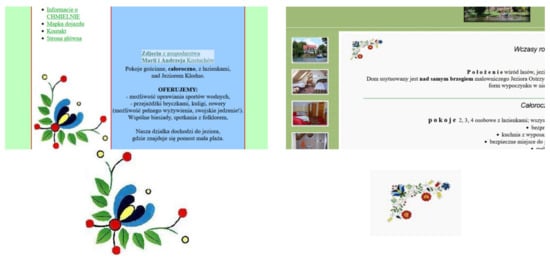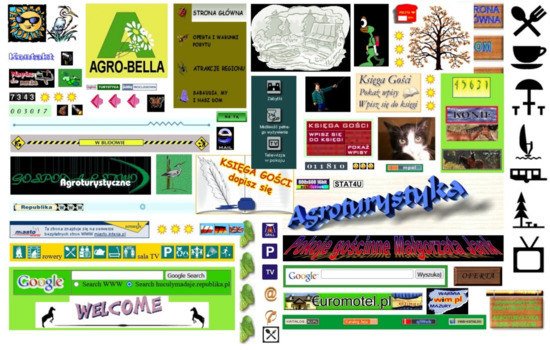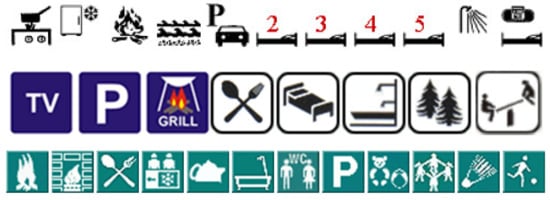Your browser does not fully support modern features. Please upgrade for a smoother experience.

Submitted Successfully!
Thank you for your contribution! You can also upload a video entry or images related to this topic.
For video creation, please contact our Academic Video Service.
| Version | Summary | Created by | Modification | Content Size | Created at | Operation |
|---|---|---|---|---|---|---|
| 1 | Karol Król | + 1205 word(s) | 1205 | 2022-01-21 07:35:38 | | | |
| 2 | Jessie Wu | Meta information modification | 1205 | 2022-01-21 08:34:37 | | |
Video Upload Options
We provide professional Academic Video Service to translate complex research into visually appealing presentations. Would you like to try it?
Cite
If you have any further questions, please contact Encyclopedia Editorial Office.
Król, K. Digital Folklore of Rural Tourism in Poland. Encyclopedia. Available online: https://encyclopedia.pub/entry/18595 (accessed on 16 January 2026).
Król K. Digital Folklore of Rural Tourism in Poland. Encyclopedia. Available at: https://encyclopedia.pub/entry/18595. Accessed January 16, 2026.
Król, Karol. "Digital Folklore of Rural Tourism in Poland" Encyclopedia, https://encyclopedia.pub/entry/18595 (accessed January 16, 2026).
Król, K. (2022, January 21). Digital Folklore of Rural Tourism in Poland. In Encyclopedia. https://encyclopedia.pub/entry/18595
Król, Karol. "Digital Folklore of Rural Tourism in Poland." Encyclopedia. Web. 21 January, 2022.
Copy Citation
Numerous development techniques and attributes that define the unique essentiality of archaic rural tourism websites in Poland have been identified. However, the use of e-folklore graphics on the websites heretofore has not been analysed.
digital folklore
Tourism
digital heritage
cultural heritage
digital artefact
1. Introduction
Not so long ago, the backbone of rural tourism marketing in Poland was websites built at the lowest possible cost and hosted on free servers [1]. The fact that the websites were developed by the farms (household members, friends) and were nonprofessional is relevant. Many were unique and considered Polish rural digital heritage [2]. They were most often developed with archaic techniques, floating frames (iframe) or tables. Their creators employed scrolling text in marquee containers, and the 900 px wide viewport was typical of 15˝ CRT monitors [1]. Still, the exceptionality and general design of such websites stemmed mainly from digital folklore elements.
According to the literature, digital folklore is often special and highly diversified. It also achieves unprecedented reach and availability. It has never been so easy to become an architect of (digital) folklore; any device with access to the Internet is sufficient. In a way, this process realises the technological ‘community’ [3].
Numerous attributes that defined the unique essentiality of archaic rural tourism websites in Poland have been identified. The research concentrated on development techniques and HTML code exploration [1][2]. However, the use of digital folklore graphics on the websites is yet to be analysed. A question arises whether such elements had been used in archaic websites of rural tourism facilities in Poland. The paper’s objective is to identify forms of digital folklore found on archaic websites of rural tourism facilities in Poland. A hypothesis emerges from the research to date [1][2] that websites of rural tourism facilities hosted on free servers have elements of digital folklore due to the development techniques.
2. Current Insight on Digital Folklore of Rural Tourism
Static websites amounted to about 83% of the sample. Among them were 13 text websites without any graphics (about 7%). Data were missing completely or partially for 73% of the websites. The copies in the digital archives were mostly missing graphic elements (Table 1). Graphic and/or textual attributes that indicated the archaic nature of the websites were identified in 51% of them (95).
Table 1. Quantitative statistics of selected development attributes.
| Development Attributes | No Graphics; Text Website | No Animated Graphics; Static Website | No Data; Content Lost |
|---|---|---|---|
| Number of websites | 13 | 154 | 136 |
| Percentage | 7.03 | 83.24 | 73.51 |
The special character of digital folklore assets emerges first and foremost from the context and the way they were used. Animated graphics were relatively rare. On the contrary, the websites’ structures were extraordinarily simple, with merely a few hypertextual elements (Table 2). The sites consisted mostly of basic HTML tags, such as <td> (tables), <img> (graphics), <a> (hyperlinks), <span>, <font>, and bulleted lists (<li>).
Table 2. The profiles of graphic elements found on the websites.
| Development Attributes | Dynamic Marquee Text Containers | Graphics: GIF | Static Elements | Dynamic Elements |
|---|---|---|---|---|
| Number of websites | 21 | 81 | 68 | 37 |
| Percentage | 11.35 | 43.78 | 36.76 | 20.00 |
The sample included several basic categories of digital artefacts. They are no longer used or very rare. For example, users are not informed today about the suggested screen resolution to best view the content because websites change to fit the display (responsiveness). No static, manually typed update dates in the footer are used nowadays. Marquee containers, SMS gateways, static visitor counters, splash screens, or guestbooks are not featured on websites anymore (Table 3). Ready-made digital components are also rarely used.
Table 3. Frequency of digital artefacts.
| Development Attributes | Digital Trims; Separating Dashed Lines | Ready-Made Digital Components | Digital Stamps | Rustic Elements of Digital Folklore | Pictograms |
|---|---|---|---|---|---|
| Number of websites | 4 | 27 | 10 | 7 | 5 |
| Percentage | 4.21 | 28.42 | 10.53 | 7.37 | 5.26 |
The sample had many digital artefacts but not many rustic elements of cyberfolklore. These were rustic graphics, static or animated (Figure 1) or graphics stylised as farm or ranch equipment and representations of fauna and flora. They were rare in the sample. Those identified were most often isolated components to accompany the text.

Figure 1. Rustic elements of cyberfolklore. Left to right: graphics from the website of makostuch.fm.interia.pl (a copy from 2003) and nabrzegu.republika.pl (a copy from 2012). Source: Internet Archive.
Some websites of rural tourism facilities used static and animated GIFs. Their primary roles were website navigation and reinforcement of the written message. In such cases, they were images of post boxes, arrows, or pictograms (Figure 2). They were usually brightly coloured to improve the appeal of the website and draw the user’s attention to selected content or functionality, such as the guestbook or contact data. Other graphics were just additions and were much less popular. The number of rustic elements was even smaller.

Figure 2. A collage of graphics found on websites of rural tourism facilities in Poland. Source: Internet Archive.
Two groups of special elements were identified among graphics on archaic websites of rural tourism in Poland: pictograms and icons characteristic of Web 1.0 (Figure 3). In most cases, they were links to web directories under a link exchange scheme. The website owner could list it in a web directory free of charge but had to link to the directory in return.

Figure 3. Icons used in website footers as part of link exchange. Source: Internet Archive.
The other element characteristic of archaic websites of rural tourism facilities in Poland is pictograms. They are graphics that inform about details of tourism offered in a universal manner (Figure 4).

Figure 4. Pictograms with information about offer details. Source: Internet Archive.
3. Summary
The 185 websites of rural tourism facilities in Poland stored in the Internet Archive. The analysis covered the oldest copies of archaic websites hosted on free servers with free URLs. The copies were analysed in terms of digital artefacts, including animated graphics and elements of cyberfolklore.
Most investigated websites were static. Many archived copies were incomplete, which could affect the results. What makes the websites special and archaic are the development technique and graphics. Some components of the websites such as marquee animations, visitor counters, guestbooks, or animated GIFs, are ‘digital time stamps’. Still, the archaism of a given component is not due to its type (kind) but the way it has been developed, used, and presented. Today, some websites have marquee-like components, which conform to current standards. Many archaic components, such as traditional guestbooks, have been replaced with comment systems and social media. The way objects are presented has evolved as well. They are dynamically adapted to the screen of the terminal. Therefore, digital artefacts can be classified, but their archaism is due to the type of the object and how it was created and presented. The function (the way it worked) matters as well.
The investigated sample contained few rustic elements of digital folklore, such as ‘digital trimming’, rural objects, natural features, plants, or animals. More popular, even though still rare, were websites stylised as ranches with ‘wooden’ graphics.
Digital copies of websites are ‘images frozen in time’. An irreversible deletion of a component, for example, due to the incompleteness of a digital copy, will create a gap in the resources, leading to link rot intensification. All digital copies, even incomplete and imperfect ones, contribute to the ‘integrity, coherence of the digital snapshot’. Therefore, the process of archiving Internet content should not be exclusive. Any actions towards preserving the entire digital ecosystem for further investigation are reasonable.
References
- Król, K. Forgotten agritourism: Abandoned websites in the promotion of rural tourism in Poland. J. Hosp. Tour. Technol. 2019, 10, 431–442.
- Król, K. Digital cultural heritage of rural tourism facilities in Poland. J. Cult. Herit. Manag. Sustain. Dev. 2020, 11, 488–498.
- Przeklasa, S. Chorwacki folklor internetowy: Geneza, definicje, przykłady. Stud. Zesz. Nauk. Inst. Filol. Słowiańskiej UJ 2017, 1, 69–87.
More
Information
Subjects:
Cultural Studies
Contributor
MDPI registered users' name will be linked to their SciProfiles pages. To register with us, please refer to https://encyclopedia.pub/register
:
View Times:
689
Revisions:
2 times
(View History)
Update Date:
21 Jan 2022
Notice
You are not a member of the advisory board for this topic. If you want to update advisory board member profile, please contact office@encyclopedia.pub.
OK
Confirm
Only members of the Encyclopedia advisory board for this topic are allowed to note entries. Would you like to become an advisory board member of the Encyclopedia?
Yes
No
${ textCharacter }/${ maxCharacter }
Submit
Cancel
Back
Comments
${ item }
|
More
No more~
There is no comment~
${ textCharacter }/${ maxCharacter }
Submit
Cancel
${ selectedItem.replyTextCharacter }/${ selectedItem.replyMaxCharacter }
Submit
Cancel
Confirm
Are you sure to Delete?
Yes
No




